
Photo by Geoffrey Bale of a tapestry in the Palazzo Reale, Genoa, Italy.
Any close and worthwhile contact with the earth tends to make one original or at least detached in one’s judgments and independent of group control.—L.H. Bailey

March 15. New beds keep a gardener happy. Eight years ago, this garden began with a six-foot diameter ring of stones around a dying plum tree. It hasn’t been easy, it isn’t pretty, it’s the best creative endeavor, it attracts and nurtures life. Nature makes a garden, humans help.

March 26, looking West from the back door on a rainy day. Ditch lilies, Hemerocallis fulva, on the rise.

March 28, facing West. Buddy Chamaecyparis, a gallon pot eight years ago, perished in July’s unprecedented heat. I didn’t give enough care, I knew it wanted shade. Farewell, Champ–who will the lilies lean on next year? Maybe something purple. The trellis poles await bamboo, a fresh-cut pile of ten-foot poles stacked by the garage. At the back of the property is the stump of an enormous Mulberry, Morus rubra, decades ago split in half six feet above the ground by a great natural force (lightning the legend, flood likely). The thick laterals extended at least 15 feet on both sides of the boundary line, sprouting to ten feet through a tangled understory of Lonicera maackii and piss Elms, Ulmus pumila. This was the eldest of three Mulberries on the property, by far the most attractive to birds, and officially on the neighbor’s side for removal. It took a crew of five and heavy machinery to do the job. Look at all the new light. This year, the aging Cherry gave a spectacular bloom and a symphony of bugs, faded and gray in this picture.

April 12. Garage bed facing East. New bamboo and the last year for this old raised bed. Self-seeded wild arugula at right; seedlings of escarole, Calendula and Asclepias center and left; snow peas starting to climb the bamboo. In the trellis beds, seeds of bitter melon, pole beans and cucamelon; and ‘Pintung Long’ eggplant seedlings next to the short bamboos. The barrow and big pots hold tomatoes, ‘Rosita’ eggplants, basil and petunias. Yellow chard and elderberry cuttings in other pots.

April 12. Garage bed facing West.

April 30. Garage bed from the main path, facing North. Tulips, Salvia and daisies on the left. Lysimachia nummularia ‘Aurea’, golden Creeping Jenny, on the ground. It is a beautiful living mulch, it’s infamous vigor kept in check by our Summer heat, drought and a thick mulch of straw in early July.
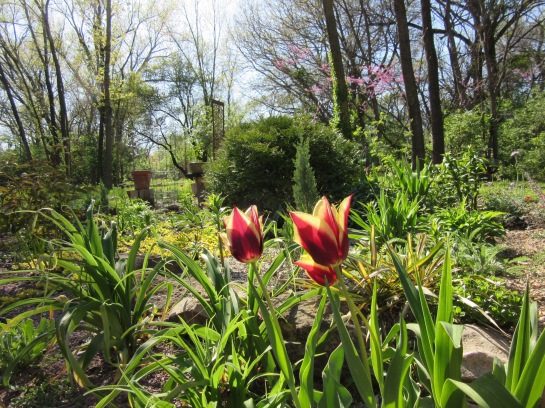
April 30. Tulipa ‘Gavota’, returning for the third year.

In early May, a couple of snapping turtles migrate from the nearby creek to the big pond on the back patio. The creek usually dries up by the end of June–but in this 2018 garden, August was wetter than April.

Robert Burns basking in Summer digs. I saw him last in early September.

May 25, Main path North of Garage Bed. Starry Allium christophii in front; glaucous leaves of Rudbeckia maxima, giant coneflower, at left; tall shoots of Helenium ‘Rubinzwerg’ back left; pink puffs of red clover, Trifolium pratense, weaving. The red patch behind the creeping jenny is self-seeded ‘Hopi Red Dye’ amaranth.

May 25. Garage bed facing West. ‘Danish Flag’ poppies in foreground, underseeded with lettuce; marigolds, jalapeno and poblano peppers along the horizontal bamboo. ‘Black Vernissage’ tomatoes in the tall cages. The few fruits harvested were fine in salads, unremarkable from the vine, no fault of the cultivar in this weather.
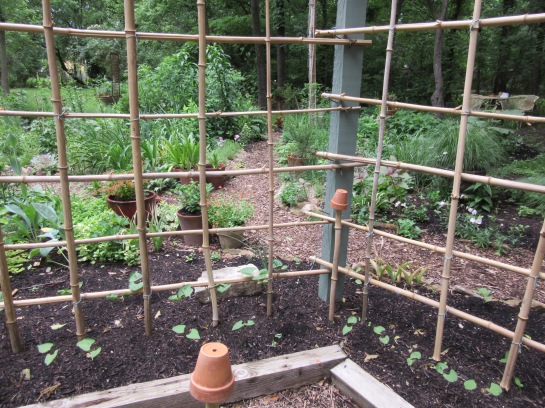
May 30. Pole Beans on the left, Cucumbers and Bitter Melon on the right. Bush Beans below. I usually plant these crops a week or two earlier–our last predicted frost date is April 21–but my tardiness made no difference this year. We went from Winter to Summer in three weeks, which included a killing frost. Pole beans, usually the most reliable crop in the garden, did poorly.

June 9, Entrance

June 6. The Ride facing West, Garage Bed, 8:30PM. Buckets of Aji amarillo and ‘Amana Orange’ tomatoes. Beans along the bamboo look their best here, heat and rabbits soon took them. Until 2018, I counted on a personal Summer’s worth of beans, cukes, okra, a few great tomatoes, mustard greens and amaranth. It flipped this year, amaranth the sole constant; peppers were delicious and abundant–Aji, ‘Fish’, Jalapeno, Poblano, ‘Santa Fe’, Serrano–and I haven’t enjoyed so much pesto in decades. Basil and all the Mediterranean herbs were unusually generous, and the potted Bay grew a foot taller. Two of seven ‘Munstead’ lavenders overwintered, a rare triumph.

June 6. Five-gallon buckets, bottoms removed, filled with loam, manure, compost and worm castings. ‘Amana Orange’ tomatoes in the left row, Aji amarillo peppers middle and right. ‘Will Rogers’ zinnias in between the buckets.

Katydid on Genovese Basil.

June 10. In front on the creekside, left to right, Burroughs elderberry, ‘Darlow’s Enigma’ rose (fifth year), and dark-leaved ‘Summer Wine’ Ninebark, Physocarpus opulus ‘Seward’ (second year). I seeded white clover as a no-mow living mulch last year and will add more this Spring.

June 5, Urn Bed face East. Rue; ‘Drumstick’ Allium; tarragon in front; Lychnis coronaria; unknown red-flowered Dianthus; and chives.
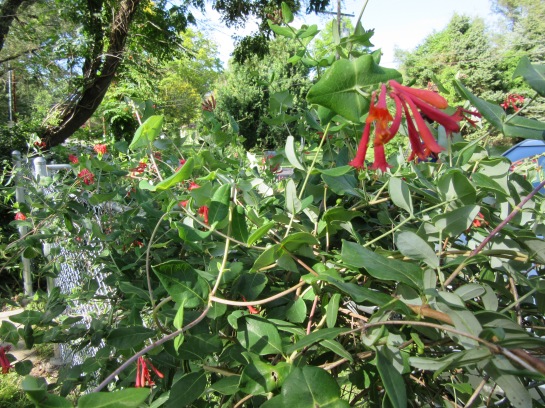
June 1. Lonicera ‘Major Wheeler’–a tough, floriferous and non-fragrant honeysuckle–on the chain-link in front.


June 5. Snake Path facing West.

Toadflax, Linaria maroccana ‘Northern Lights,’ blooming at the beginning of June from a mid-March sowing. I have seen great sweeps of toadflax blooming wild in Spain but this is the first time I’ve had it in the garden. Charming.

June 15. The Gravel Bench, facing East.

Late June. Gravel Bench, facing North. Echinacea purpurea, juvenile Ricinus communis ‘Carmencita’, and red ‘Serengeti’ lilies. Rosa ‘At Last’ and Petunia ‘Ultra Blue Star’ in the bench pots. Elderberry blooms fading in back.
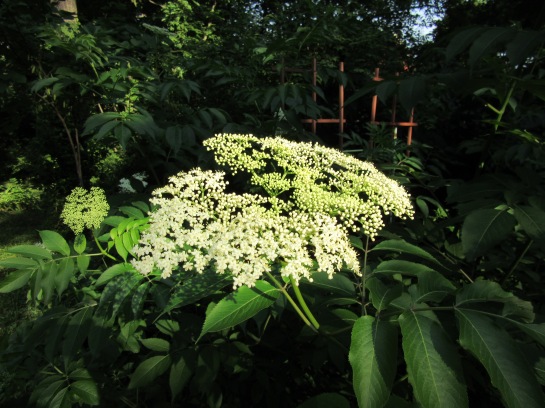
June 25. Flowers of Sambucus canadensis ‘Bob Gordon,’ collected from the wild in Missouri in 1999. Mr. Gordon encountered his namesake during a routine ramble in the woods, describing it as a specimen of unprecedented size and vigor. He wasn’t kidding: two-year plants from seven-inch cuttings are now eight feet tall. Harvesting elderberries is a fiddly task. After cutting the berry clusters, I put them in the refrigerator for a few days which seems to help loosen the berries from the stalks. All parts of the elderberry plant contain toxic cyanide compounds, only fully ripened berries should be consumed, stems and green berries must be removed. Six hours of careful picking yielded three gallons of useful berries which became one gallon of elderberry liqueur: vodka, elderberries, lemon and orange zests, black peppercorns and brown sugar syrup; strained and aged for at least three months.

“Young Hare” by Albrecht Durer, 1502. Photo Wikimedia Commons.
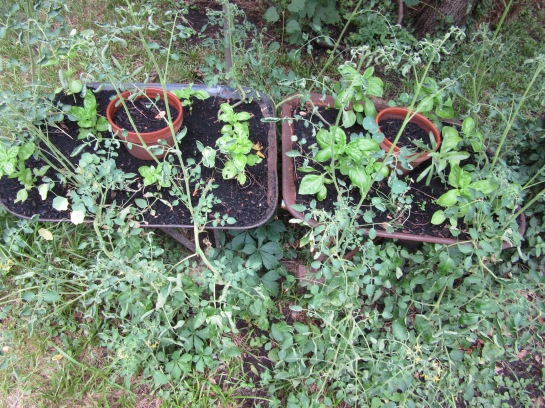
July 1. The small barrows, home to ‘Cherry Falls’ tomatoes (bred to cascade), bright orange ‘King Theodore’ nasturtiums and ‘Genovese’ basil. ‘Red Globe’ amaranth in the pots. The tomatoes had unusually curled leaves and yielded poorly, which I now know is due to juglone, a growth-stunting compound contained in all parts of black walnut trees. I knew the barrows were under the drip line of the walnuts but I thought juglone was soil-based. Wrong; plus tomatoes are highly allergic to juglone. Even rainwater dripping from the walnut leaves was enough to cause harm, though it didn’t bother the basil at all.

July 7, facing West. Green light before a storm. Pale lavender blooms of bee balm, Monarda fistulosa, in the distance. Plenty of bumble and small bees this year but very few honeybees.

July 15.

July 15. Lilium ‘Scheherazade’. Photobomb Monarda.
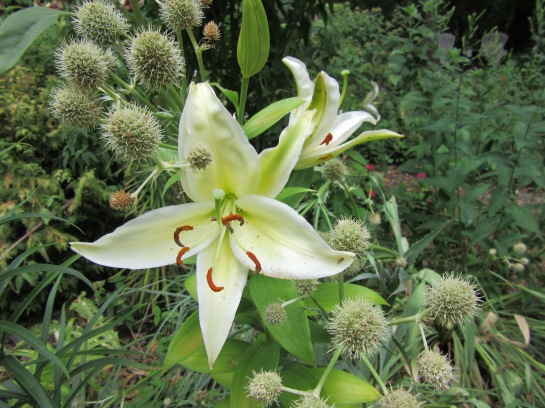
July 15. Lilium auratum ‘Gold Band’ with ‘Rattlesnake Master’, Eryngium yuccifolium.

July 15. Tiger Lilies budded at once, blooms barely lasted four days.

August 9. Little Path, facing East. Daylilies, asters, snapdragons and lilies in front. Ipomoea ‘Solar Tower Black’ on the pole at left. It really does climb, eight feet by first frost.

August 12. Seedlings of flowering tobacco, Nicotiana x mutabilis ‘Bella’, on the move, while tender and pinnate-leaved Cassia didimobotrya languishes in the hot semi-shade of the mulberry tree. I’ll replace it with the native and perennial Cassia marilandica in 2019, not as fine in structure but much tougher. A border of catmint in front. self-seeded Leonitis everywhere.
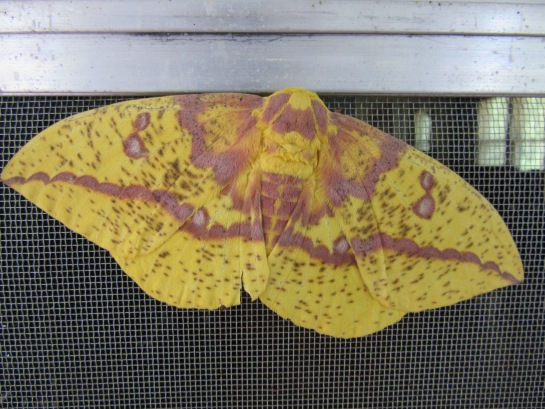
Eacles imperialis on the front screen. Wow! Indulgent of my documentation, measured relaxed wingspan just under seven inches. Shook the screen twice but it hung tight. Early next morning, it was gone.


Lilium ‘Bright Diamond’ and Hemerocallis ‘South Seas’.

Hard storms getting harder.

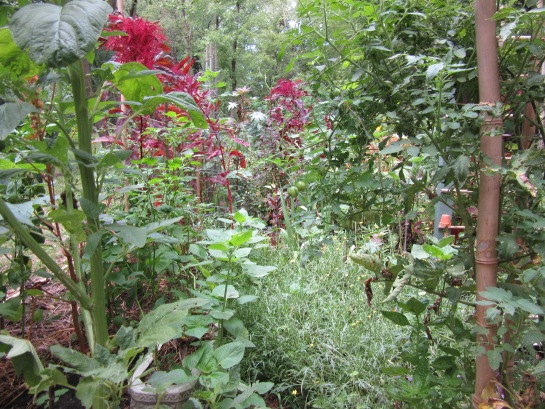
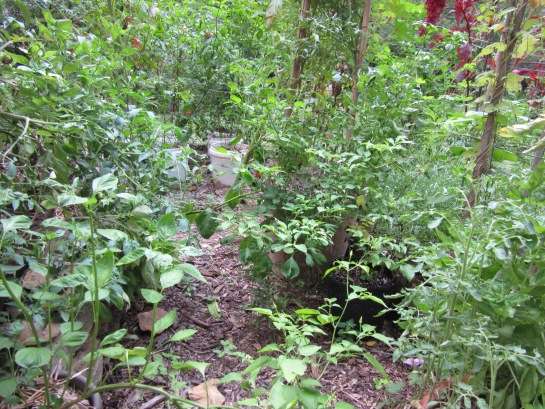
Solanaceae.

Main Path facing South. Berberis ‘Tangelo’ front left.


Main Path from the South.

Sparse fruit on native Elderberry, Sambucus canadensis ‘Burroughs Creek’.




